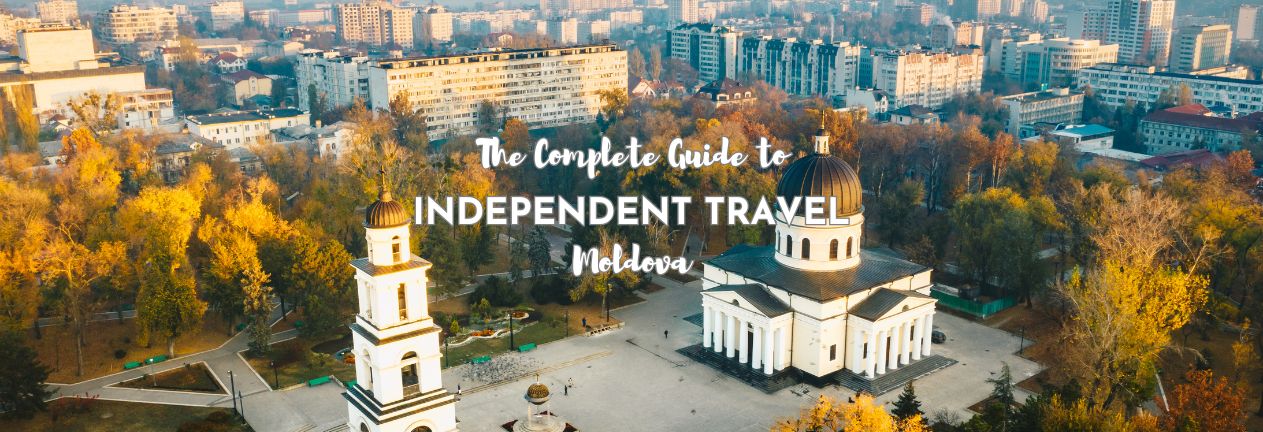Moldova is exactly the kind of place I love to travel. It’s quiet, still, even now, under-the-radar. It definitely feels like you’re exploring the unknown. This isn’t a regular crowded European capital and there aren’t endless tour buses here. There are rural landscapes dotted with monasteries, vineyards producing some of the best wine in Europe stretching to the horizon, walnut trees lining the roads. That’s not a drawback. That’s exactly the draw. Here’s our guide to independent travel in Molodova.
THIS POST MAY CONTAIN COMPENSATED AND AFFILIATE LINKS MORE INFORMATION IN OUR DISCLAIMER
In this guide, I’ll take you through everything you need to plan your own trip: how to get in, how to move around, the best times to visit, and the experiences that shouldn’t be missed. Moldova might not be polished, but that’s exactly why you should go — it’s Europe at its most real, and once you’ve been, you’ll wonder why more people haven’t figured it out.
Moldova is one of Europe’s least-visited countries, which makes it fascinating and interesting. English is definitely not everywhere, in fact, its hardly anywhere. My sim card didn’t work for the entirety of our first visit. There’s a definite ex-Soviet grittiness to the place, but its not rushed, and there are underground wine cellar that run for kilometres here, so I mean, what’s not to love?
Why Travel Independently in Moldova
Independent travel and Moldova are a natural fit. You’re not going to find big tour groups here yet. There aren’t (to my mind) a big top ten checklist of places to see, and things to do. This is a place for the curious to visit. You’re going to want to be flexible to visit here. The trains are slow, marshrutkas leave when they’re full rather than when a timetable says so, and the signage in the museums? Yep you’ll need to use imagination, a dose of Google translate and a local guide.
PRACTICAL TRAVEL TIPS
- 🛡️ Get Travel Insurance: Civitatis includes medical expenses, repatriation, theft, luggage delays. No deductibles or upfront payments. Get a quote here.
- 💰 Read about the Currency in Moldova and ATM fees.
- 🔌 Check out Moldova’s plug, socket & power situation.
- 📶 Internet, maps and data on the go. eSims for Moldova
Cost is another reason to travel here. Moldova is one of the cheapest countries in Europe. Travelling independently means you can stretch your budget even further by choosing where to splurge (maybe a night in a boutique Chișinău hotel) and where to save (a marshrutka to Orheiul Vechi costs less than a cup of coffee in London).
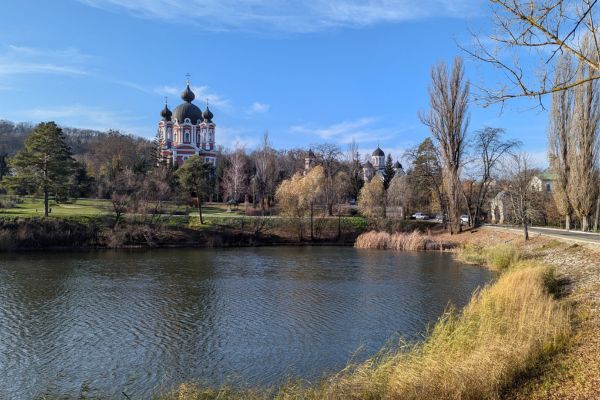
It’s relatively diverse, though, you can visit an ancient rural monastery in the morning, have lunch at a local restaurant and then head wine tasting at one of those massive underground wineries that the country is famous for in the afternoon.
So why travel independently in Moldova? Because it’s the best way to see the country as it really is — relaxed, welcoming, and a little rough around the edges, but all the better for it.
How to Get to Moldova
Getting to Moldova is easier than most people think, but you do need to plan it a little differently than the bigger European destinations. The country sits between Romania and Ukraine, and because it isn’t on every airline’s route map, you’ll either fly into Chișinău or come overland from Romania. Both options work well — it just depends on where you’re starting from, how much time you have and how adventurous you’re feeling. (When the war in Ukraine is over, we plan to go back and go overland, but that’s not on the cards for now).
Flying into Moldova
The main entry point is Chișinău International Airport, about 15 kilometres (9 miles) from the city centre. Direct flights connect Chișinău with cities like London Luton, (Wizz Air flies here) Bucharest, Vienna, Istanbul, Frankfurt, and some Italian hubs. Low-cost airlines, like Wizz Air, do occasionally run routes here, but most flights are through national carriers and regional connections.
Chisinau is a great place to base yourself – read my guide to the city here.
Immigration is usually straightforward: many nationalities, including those from the EU, UK, USA, Canada, and Australia, can enter visa-free for up to 90 days in any 180-day period. Just check your passport has at least six months’ validity, and you’re good.
The airport itself is small and manageable. Buses and minibuses run into the city, but you can easily take a taxi or use Yandex, which is cheap and reliable. There is of course the usual mafia of taxi drivers waiting to pick you up and charge you more than the going rate if you don’t know what that it. Read my guide on going from Chișinău airport to Chișinău here.
Coming Overland from Romania to Moldova
If you like a good border-crossing story, overland travel from Romania into Moldova is a classic independent travel experience. We were almost tempted to fly into Bucharest and then take the train from there, but we didn’t have time for this trip. Next time!
Buses from Romania to Moldova
There are frequent buses and minibuses from Iași and Bucharest into Chișinău, with journey times ranging from four to eight hours depending on the route and the border queue. You can easily book buses online here. Pick during the day or overnight, it’s all very easy.
Trains from Bucharest to Chișinău
Trains also run between Bucharest and Chișinău – they take about 13 hours and are sleeper trains. You can also, of course opt for the couchette carriages (and just sit in a reclining chair allnight.
Book your train tickets between Bucharest and Chișinău here
You can book online using either the Romanian trains website, or the Moldovan train website. And its worth taking the train just to see the train station in Chișinău – it is FABULOUS.
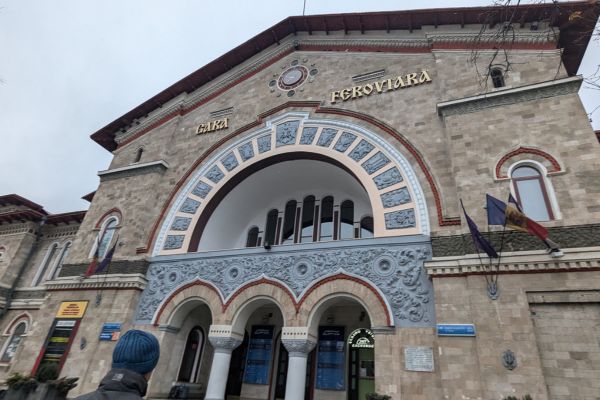
Booking on the Romanian train website opens 60 days in advance, and its 30 days in advance on the Moldovan site. There are first class sleepers (2 berth) and second class sleepers (4 berth) and there’s also a buffet car.
Getting Around Moldova
Once you’ve made it into Moldova, the real adventure begins. And the transport is relatively easy. You might use the very limited train service, you’ll most likely get in one or two of the shared minibuses that usually seat 15 people, the marshrutkas, perhaps use long-distance buses, maybe a rental car if you want to dive into the countryside. But this is also a country where you can work with local guides and their cars without breaking the bank. And they’re worth their weight in gold.
The capital city, Chișinău, is the main hub for all transport here in Moldova
Marshrutkas
Marshrutkas are minibuses that serve as Moldova’s main form of public transport. They’re chatoric, and they leave when they’re full rather than on a strict timetable, so it’s best to show up at the bus station a little early and grab a seat. They are cramped, but they’re cheap and frequent, running between Chișinău and almost every town and village. You won’t find English signage, but Moldovans are generally helpful and will point you in the right direction if you need help.
Trains
Moldova’s train network is small and slow, but there’s a certain charm to taking them. The route between Chișinău and Bălți seems to not run more often than it does run. And the route from Chișinău to Tiraspol is suspended because of the war in Ukraine. SO unless you’re taking that train from Bucharest into Chișinău, then its probably not currently worth looking at Moldocan trains as a reliable form of transport.
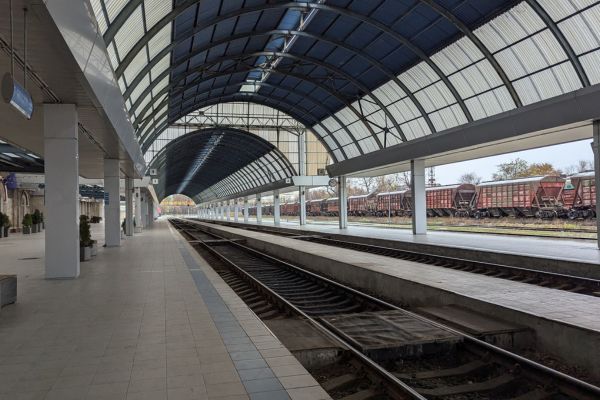
Buses
For longer routes where a marshrutka isn’t practical, buses are the next best option. They’re more comfortable than minibuses, though still basic by Western standards. Bus stations in Chișinău and regional towns are easy to navigate once you know your destination. You can book some of the routes online.
Car rental
If you’ve any experience of driving in Eastern Europe then you’ll be fine in Moldova. It’s the same here, some potholes, drivers didn’t seem too crazy and mapping systems like Google work reasonably well. You’ll need your drivers licence, and usually an International Driving Permit. If you’re just visiting Chișinău then don’t bother with a car, traffic is crazy especially during rush hours.
Taxis and ride-hailing
In Chișinău, apps like Yandex and Bolt are cheap and reliable. There’s no Uber here though. Once you get outside the capital it’s a little less available, so for instance if you’re wanting to go to the Orhei Monastery, you might find yourself a Yandex to get you there, but you’ll have to pay them to wait for you and bring you back.
Moldova Safety, Costs and Visas
The capital might feel a little grungy when you arrive, but not because its unsafe, more because its relatively poor. Moldova is one of the poorest countries in Europe. We certainly didn’t feel that we needed to take any more precautions here than we would anywhere else. (Keeping an eye on belongings, trusting instincts. We also didn’t feel as though anyone ripped us off either.
Transnistria
If you’re planning or at least thinking of a visit to Transnistria, then that’s another matter. Not that that means its not safe, but you might want to check with your government whether you’re supposed to go or not. I’ve written about Transnistria here, and yes, we did visit and felt completely safe the whole time (I suppose having a shot of vodka with your lunch kind of helps eh?), but the breakaway region has its own rules and border checks.
Visiting is, however, straightforward for most nationalities. You’ll be given a slip of paper on entry instead of a passport stamp, and it’s valid for 24 hours unless extended.
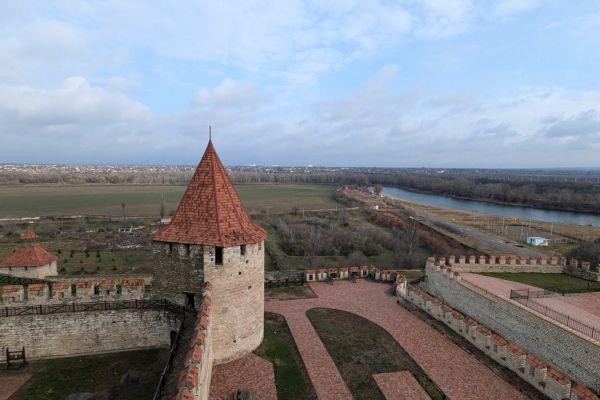
Visas for Moldova
Anyways, back to Moldova. You probably don’t need a visa for Moldova. Citizens of the EU, UK, USA, Canada, Australia, and many other countries can enter visa-free for up to 90 days within any 180-day period. Your passport should be valid for at least six months beyond your arrival date.
Costs in Moldova
One of Moldova’s biggest draws is how affordable it is. Although this might lull you into a false sense of security when you go wine tasting. Don’t get me wrong, the Moldovan wine we drank was amazing. And yes we brought some home. But its not cheap wine. So don’t go thinking that this a cheap drinking place. It’s not. It’s quality stuff and priced accordingly, but it still cheaper than other wine producing countries in Europe.
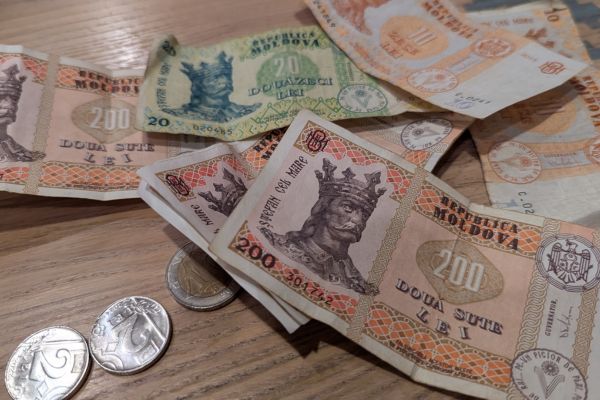
Accommodation ranges from budget hostels to boutique hotels,public transport is incredibly cheap — a marshrutka journey might set you back less than the price of a coffee elsewhere in Europe. Cash is still king in Moldova. The currency is the Moldovan leu, and while cards are accepted in Chișinău, smaller towns and villages often rely entirely on cash. ATMs are common in larger towns, but it’s best to carry some leu with you when travelling to rural areas. My guide to Moldovan currency and ATM fees in Moldova is here.
Useful Info for Traveling to Moldova
- Currency: Moldovan leu (MDL). Cash is essential outside Chișinău.
- Language: Romanian is official. Russian widely spoken, especially in Transnistria. English is limited.
- Visas: Most travellers, including EU, UK, US, Canadian, and Australian citizens, get 90 days visa-free in any 180.
- Power plugs: European two-pin (type C and F). Bring an adapter if you use other types. Read my guide to power requirements for Moldova here.
When to Go and How Long to Spend
Moldova has four distinct seasons, and the best time to visit depends on what you want out of your trip. Independent travel here is possible year-round, but some seasons are definitely easier and more rewarding than others. Our first visit? We went at the end of November. And yes it was COLD.
Seasons and Weather in Moldova
Spring, from April to May, however, is one of the loveliest times to be in Moldova. The countryside bursts into green, fields are full of wildflowers, and the weather is mild without being stifling. Tourist numbers are almost non-existent, so you’ll often have sites like Orheiul Vechi or monasteries practically to yourself.
Summer, between June and August, are hot and the days are long. It is the busiest time for festivals. Expect temperatures to climb above 30 degrees Celsius, particularly in July. This is also when vineyards are at their most active, and you’ll see the countryside buzzing with activity. If you don’t mind the heat, summer is perfect for combining city time in Chișinău with day trips into the hills or villages.
Autumn, especially September and October, is the best time to travel. This is wine harvest season, and Moldova takes it seriously. Vineyards invite visitors to tastings and festivals, the landscape glows with autumn colours, and the weather is still warm. It’s a great time to plan a route that mixes cultural sites with countryside stays.
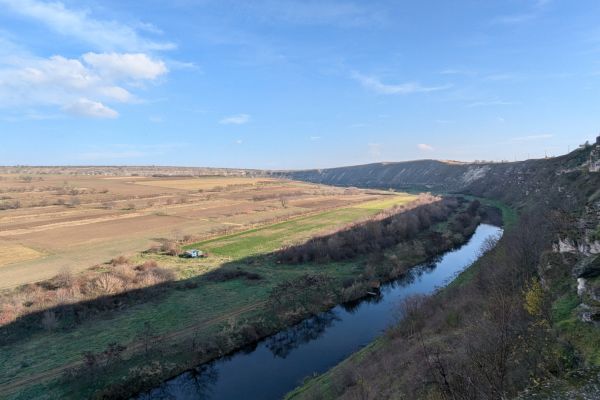
Winter, from November through March, is cold and grey. Snow is common in rural areas, and many attractions feel shut down. However, you’ll find the underground wineries, and top places like Orhei Monastery still open. Chișinău, as the capital, of course is also open.
How long to spend in Moldova
A short trip of three to five days gives you enough time for Chișinău, Orheiul Vechi, and a wine cellar or two. If you can stretch to a week, you’ll be able to add in Transnistria, Gagauzia, and a few other spots.
If you’re already travelling in Romania, then it’s a great side trip (and a fabulous overnight train journey), but our visit here was just to Moldova.
Essential Moldovan Experiences
Moldova isn’t the kind of place where you’re going to tick off a long list of blockbuster attractions, there are a few things that you’ll want to do, see, and some fabulous tastes that you mustn’t miss.
In Chișinău, the capital might have wide streets , but it doesn’t feel like a big capital. There are crumbling Soviet-era buildings, great parks to drink coffee (yes even in December!). The Central Market is a must for a crash course in everyday Moldovan life — fruit stalls, homemade cheeses, and endless varieties of sunflower seeds. My guide to Chisinau is here.
Orheiul Vechi is the number one place you should visit. It’s a dramatic archaeological complex sitting on a limestone ridge above the Răut River and includes cave monasteries carved straight into the rock. Don’t miss the nearby restaurant (its open most of the year, and you can read about it in my guide to Orheiul Vechi here), for some fabulous local food and a great place to try a LOT of Moldovan food.
Wine is key to a visit to Moldova, and no trip is complete without descending into one of its legendary underground cellars. Cricova and Milestii Mici are vast labyrinths, with roads wide enough for cars running between barrel-lined tunnels. Read my guide to visiting Cricova here.
If you’re here and interested, then cross into Transnistria. This self-declared republic feels like a Soviet time capsule, with statues of Lenin still standing and its own currency that can’t be used anywhere else. Spending a day in Tiraspol is one of the most unusual experiences you’ll find in Europe.
MOLDOVA TRAVEL RESOURCES
AIRPORT TRANSFERS
24/7 pickup & drop off. Trusted, local English speaking drivers. Prebook & prepay online with cards.
Book a Transfer
HOTELS AND APARTMENTS
See choices here
Rooms with a view? Budget rooms? Need a washing machine? The best choice of hotels & apartments.
TOURS & ATTRACTIONS
Most excursion choices, small group tours, skip-line tickets, free cancellation and top local guides.
Top options here.
CAR RENTAL OPTIONS
Choose cars here
Best choice of vehicles, automatics, large or small cars, child seats. Book early for more options.
Final Words on Traveling to Moldova
If you’re looking for a check list of places to go and things to see, Moldova isn’t going to keep you long. It’s a fascinating place to come. You won’t need weeks here. But you will need a little flexibility and a lot of sign language, as once you leave the capital there’s not a great deal of English spoken. What you will find, though, is that you’re rubbing shoulders with locals, drinking great wine, easting some fabulous food and finding a few surprises along the way.
ASocialNomad is a participant in the Amazon Services LLC Associates Program, an affiliate advertising program designed to provide a means for sites to earn advertising fees by advertising and linking to amazon.com, amazon.co.uk, and amazon.ca. Amazon and the Amazon logo are trademarks of Amazon.com, Inc. or its affiliates. As an Amazon Associate, I earn from qualifying purchases.
